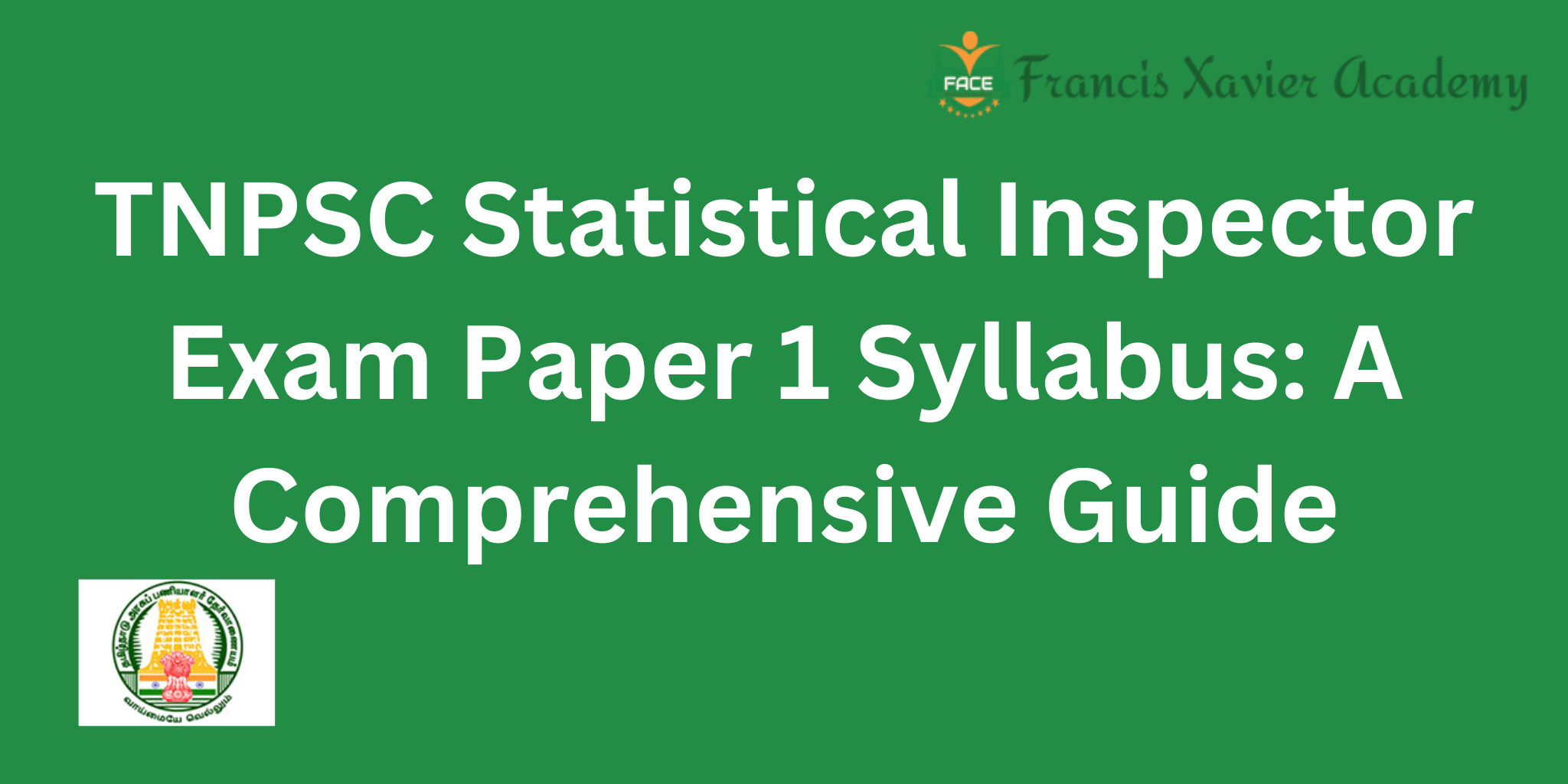
The TNPSC Statistical Inspector syllabus is a crucial component for candidates preparing for the exam. Understanding the syllabus thoroughly is essential for effective preparation and to ensure that you focus on the right topics. This blog will break down the various sections and provide insights into what to expect, helping you navigate the key areas that are vital for success in the TNPSC Statistical Inspector Paper 1 exam.
Unit I: Algebra and Trigonometry
This unit deals with various aspects of algebraic equations, matrices, and the properties of groups and rings. Topics include:
- Theory of Equations: Polynomial equations, imaginary and irrational roots, and methods like Newton-Raphson, Cardan’s method, and Horner’s method.
- Summation of Series: Binomial, Exponential, and Logarithmic series, as well as using differences for summing finite series.
- Matrices: Symmetric, skew-symmetric, Hermitian matrices, eigenvalues, diagonalization, and solving systems of linear equations.
- Groups and Number Theory: Properties of cyclic groups, prime numbers, Fermat’s and Wilson’s theorems, and divisibility rules.
Unit II: Calculus, Coordinate Geometry of 2 Dimensions, and Differential Geometry
This unit focuses on calculus and its application in coordinate geometry and differential geometry:
- Differentiation: nth derivatives, Leibnitz’s theorem, partial differentiation, and methods for maxima and minima.
- Integration: Methods of integration, properties of definite integrals, and applications of double and triple integrals for area and volume.
- Conics: Parabola, ellipse, hyperbola, and their properties such as asymptotes, conjugate diameters, and focal points.
Unit III: Differential Equations and Laplace Transforms
Candidates will be tested on first and second-order differential equations, Laplace transforms, and partial differential equations (PDE):
- Differential Equations: Solving equations using methods like variation of parameters and Clairaut’s form.
- Laplace Transforms: Applications to solving first and second-order linear differential equations.
- PDE: Formation and solution of partial differential equations, including Charpit’s method and Lagrange’s equations.
Unit IV: Vector Calculus, Fourier Series, and Fourier Transforms
This unit covers vector calculus and its application to Fourier analysis:
- This unit covers vector calculus and its application to Fourier analysis:
- Vector Differentiation: Gradient, divergence, curl, and directional derivative.
- Fourier Series and Transform: Expanding periodic functions, sine and cosine transforms, Parseval’s identity, and convolution theorem.
Unit V: Algebraic Structures
In this section, candidates will focus on advanced algebraic structures such as groups, rings, and vector spaces:
- Groups and Subgroups: Properties, Lagrange’s theorem, and normal subgroups.
- Rings and Vector Spaces: Concepts of integral domains, Euclidean rings, and linear transformations, including canonical forms.
Unit VI: Real Analysis
This unit assesses understanding of sequences, series, and the Riemann integral, focusing on real-valued functions and their properties:
- Sequences and Series: Convergence, divergence, Cauchy sequences, and absolute convergence tests.
- Metric Spaces: Understanding of limits, continuous functions, and compactness in metric spaces.
Unit VII: Complex Analysis
This unit focuses on complex functions and their integrals:
- Analytic Functions: Cauchy-Riemann equations, harmonic functions, and mappings.
- Integrals and Series: Cauchy-Goursat theorem, Taylor series, and Laurent series, along with residue calculus and evaluation of real integrals.
Unit VIII: Dynamics and Statics
Candidates will be tested on the fundamentals of dynamics and statics:
- Dynamics: Motion of particles, Newton’s laws, central forces, and projectile motion.
- Statics: Equilibrium of forces, Lami’s Theorem, friction, and center of gravity calculations for various bodies.
Unit IX: Operations Research
Operations research is a critical part of this syllabus, including optimization and queuing theory:
- Linear Programming: Simplex method, duality, sensitivity analysis, and transportation problems.
- Queuing and Inventory Models: M/M/1 systems, inventory models like EOQ, and game theory for strategic decision-making.
Unit X: Mathematical Statistics
This unit covers various aspects of probability theory, statistical inference, and hypothesis testing:
- Probability Theory: Laws of probability, conditional probability, Bayes’ theorem, and random variables.
- Statistical Inference: Point estimation, Cramer-Rao inequality, hypothesis testing, and analysis of variance (ANOVA).
- Distributions: Binomial, Poisson, Normal, and other distributions, as well as their properties and applications in testing.
Conclusion
The TNPSC Statistical Inspector Exam Paper 1 syllabus is extensive and requires thorough preparation across a wide range of mathematical and statistical concepts. Candidates should focus on understanding core principles, practicing problems, and reviewing key theories to excel in the examination. By dividing your preparation into these units, you can approach each topic systematically and perform confidently in the exam.
 Now
Now